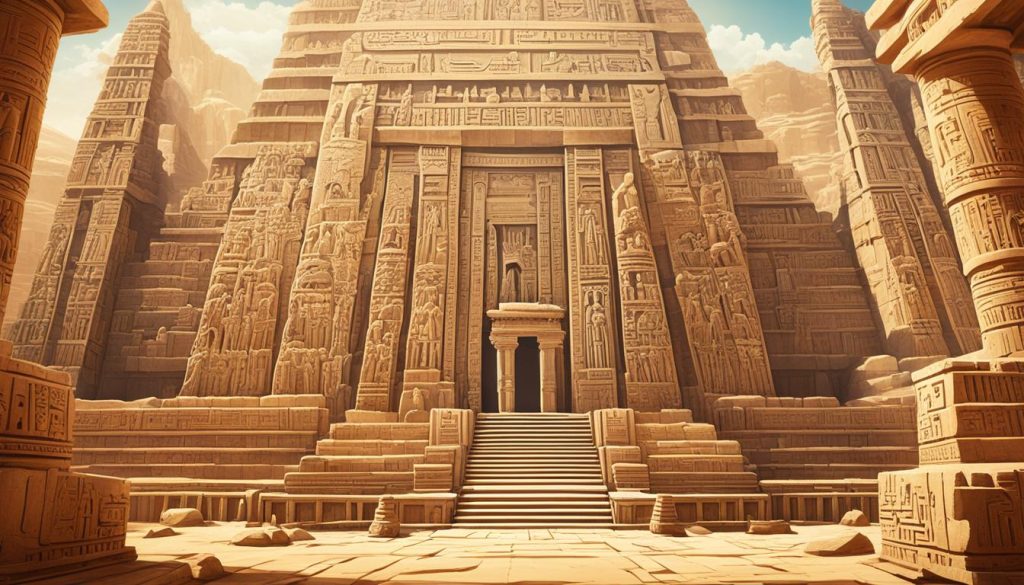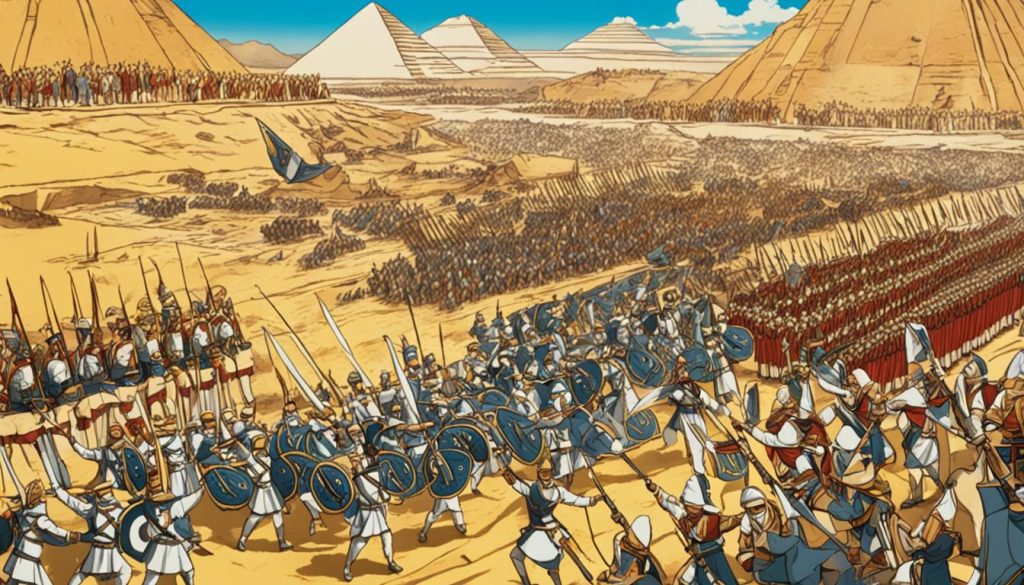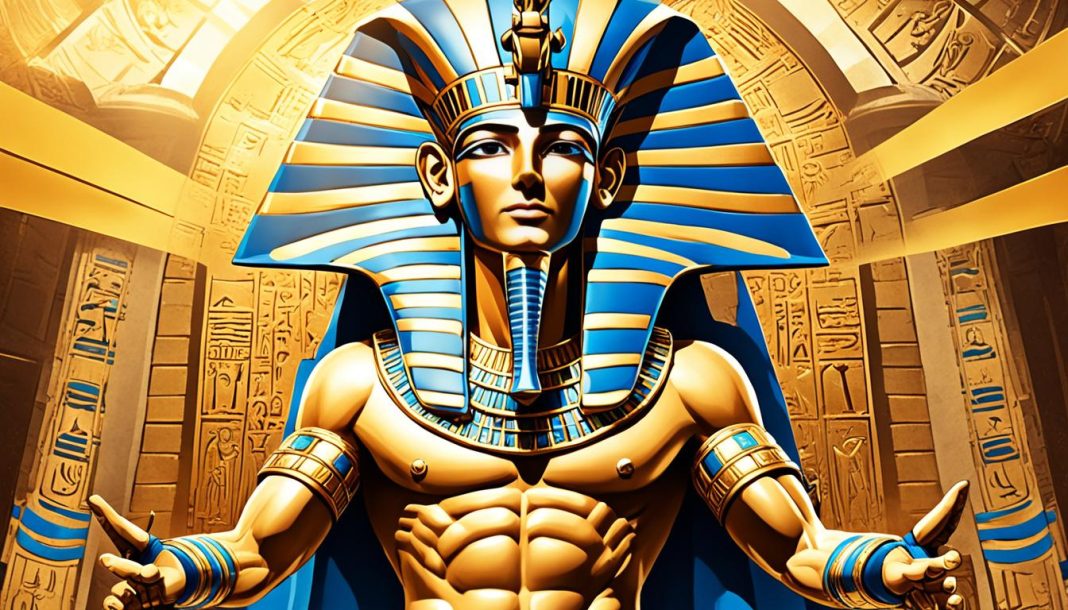Pharaoh Seti I, a powerful ruler of the 19th Egyptian dynasty, emerged during a critical period in ancient Egypt’s history. After the controversial reign of Akhenaten, Seti I aimed to restore Egypt’s greatness and revive its cultural and religious traditions. But what exactly were Seti I’s accomplishments? How did his reign shape Egypt’s future? And what is his enduring legacy?
Key Takeaways:
- Seti I was a pharaoh of the 19th Egyptian dynasty, known for his efforts to restore Egypt’s greatness.
- His accomplishments include military triumphs, prolific temple constructions, and a lasting legacy for his family.
- Seti I’s family included his wife Tuya and his children Ramesses II and Henutmire, who continued his dynasty.
- He played a significant role in reclaiming Egyptian territories and expanding Egypt’s influence.
- Seti I’s temples, such as the Abydos Temple, showcased the close connection between pharaohs, gods, and the public.
Seti I’s Family and Dynasty
Pharaoh Seti I, a prominent ruler of ancient Egypt, had a strong connection to his family and played a significant role in shaping his dynasty. Seti I’s immediate family consisted of his wife, Tuya, and his children, Ramesses II and Henutmire.
His son, Ramesses II, would go on to become one of Egypt’s most renowned pharaohs, known for his military campaigns and architectural achievements. Seti I’s dynasty, known as the 19th dynasty, left a lasting impact on ancient Egyptian history.
Seti I’s Titles and Names
Pharaoh Seti I, also known as Menmaatre Sety Merenptah, held various titles that highlighted his divine connections and notable achievements in ancient Egypt.
During their reigns, pharaohs often adopted multiple names, signifying their divine associations and emphasizing their status as the earthly representation of gods. Seti I embraced this tradition and assumed titles that exemplified his power and divine lineage.
One of his titles was “Menmaatre,” which means “Eternal is the Justice of Re.” This name emphasized Seti I’s connection to the sun god, Re, and underscored his commitment to justice and order in Egyptian society.
Another significant title held by Seti I was “Sety Merenptah,” which translated to “Man of Set, Beloved of Ptah.” “Sety” referred to the god Set, associated with chaos and power, while “Merenptah” honored the god Ptah, the guardian of craftsmen and artisanal skills.
With these titles, Seti I asserted his divine authority and claimed a direct connection to the gods who played a vital role in Egyptian mythology.
Intricate Carvings and Symbolism
Seti I’s titles were often accompanied by intricate carvings and symbolic representations in temples and tombs. These inscriptions immortalized his divine connections and conveyed his accomplishments for generations to come.
In the Abydos Temple, one of the monumental structures built by Seti I, elaborate hieroglyphics portrayed the pharaoh’s titles and emphasized his divine lineage. The carvings showcased Seti I’s devotion to the gods and his dedication to upholding justice and order.
The detailed carvings and symbolic representations in Seti I’s temples serve as a testament to his monumental reign and his enduring presence in Egyptian history.
Seti I’s Military Triumphs
Pharaoh Seti I, a powerful ruler of ancient Egypt’s 19th dynasty, was known for his impressive military triumphs, cementing his place in history as a formidable warrior and leader. Seti I engaged in numerous battles and military campaigns, reclaiming territories in Canaan and Syria, and securing victories over formidable adversaries.
One of Seti I’s most notable achievements was his defeat of the Hittites, a formidable empire in Anatolia. This victory demonstrated Seti I’s military prowess and strategic acumen, solidifying his reputation as a force to be reckoned with. His successful campaigns also extended to the subjugation of Libyan tribes, further expanding Egypt’s influence in the region.
Another significant encounter in Seti I’s military career was his confrontation with the Asian nomads. While it is debated whether these nomads were the Hebrews, the encounter showcased Seti I’s determination to protect Egyptian interests and maintain control over his kingdom’s borders.
Throughout his reign, Seti I’s military triumphs not only secured territorial gains but also brought stability and prosperity to Egypt. His success on the battlefield reflected his leadership abilities and his commitment to upholding Egypt’s power and influence in the region.
Seti I’s military triumphs not only demonstrated his strength as a warrior but also his dedication to protecting Egypt’s interests. His strategic campaigns and conquests ensured the security and prosperity of his kingdom, leaving a lasting impact on Egypt’s history.
Seti I’s Temple Constructions
Pharaoh Seti I, known for his remarkable accomplishments, was also a prolific builder. He left a lasting legacy through the construction of monumental temples that showcased the close connection between pharaohs, gods, and the public.
One of Seti I’s notable temple constructions was the Abydos Temple, dedicated to the worship of gods. This magnificent temple complex, located in Abydos, Egypt, remains an awe-inspiring architectural marvel to this day.
Another significant contribution by Seti I can be seen in the Hypostyle Hall at Karnak. This colossal hall, adorned with intricate carvings and hieroglyphics, served as a sacred space for religious ceremonies and offerings.

These impressive temple constructions stand as a testament to Pharaoh Seti I’s vision and artistic prowess, attracting visitors from all over the world who marvel at their grandeur and historical significance.
Seti I’s Tomb and Discoveries
Pharaoh Seti I’s tomb, known as KV17, is a significant archaeological discovery located in the Valley of the Kings in Egypt. It is one of the deepest royal tombs in the valley and is celebrated for its intricate decorations and historical significance.
Discovered in 1817 by Giovanni Battista Belzoni, the tomb of Seti I holds great importance in understanding the burial practices and beliefs of ancient Egyptians. The elaborate carvings and hieroglyphics found within depict scenes from Egyptian mythology, providing valuable insights into the culture and religious practices of the time.
The tomb’s extensive decorations feature breathtaking artwork, including vivid depictions of gods and pharaohs, intricate carvings of offerings and rituals, and breathtaking wall paintings. These artistic masterpieces highlight the skilled craftsmanship and artistic abilities of the era.
Seti I’s tomb provides a glimpse into the lavish funerary rites of the Egyptian royalty, showcasing the grandeur and reverence with which pharaohs were laid to rest. The discovery of this tomb has greatly contributed to our knowledge of ancient Egyptian burial customs and offers a unique opportunity to study the culture and history of the New Kingdom.
Exploring the tomb of Seti I is an awe-inspiring experience, allowing visitors to immerse themselves in the rich tapestry of ancient Egypt’s past. The intricate details and symbolism found within the tomb offer a captivating glimpse into the beliefs and aspirations of one of Egypt’s most renowned pharaohs.
Seti I’s Achievements and Legacy
Pharaoh Seti I’s reign marked a significant period of revival for ancient Egypt, both in terms of military power and economic prosperity. His accomplishments played a crucial role in restoring Egypt’s greatness and expanding its lands. Seti I’s actions laid a solid foundation for his son Ramesses II to rule in relative peace and continue his father’s legacy.
As a formidable military strategist, Seti I achieved numerous victories, reclaiming territories in Canaan and Syria and defeating the Hittites. He also subdued Libyan tribes and faced off against Asian nomads, potentially identified as the Hebrews. These military triumphs strengthened Egypt’s grip on its empire and secured its borders, contributing to the overall stability of the region.
“Seti I’s military campaigns were instrumental in consolidating Egypt’s dominance and safeguarding its territories.”
Beyond military conquests, Seti I’s legacy is also evident in his extensive contributions to temple construction. He was a prolific builder, leaving a lasting mark on Egypt’s architectural landscape. Notable among his temple constructions is the renowned Abydos Temple, dedicated to the worship of gods.

Seti I’s dedication to constructing magnificent temples showcased the close connection between pharaohs, gods, and the public. These temples served as centers of religious worship and acted as a powerful symbol of the pharaoh’s divine authority. Seti I’s devotion to temple construction contributed to the flourishing religious and cultural life of ancient Egypt.
“Seti I’s temple constructions were a testament to his devotion to the gods and his desire to solidify his reign as a pharaoh.”
Furthermore, Seti I’s tomb, known as KV17, is a testament to his achievements and artistic contributions. Located in the Valley of the Kings, this elaborate burial site holds Seti I’s mummy. Its intricate decorations and grandeur reflect the wealth and power of this remarkable ruler.
In summary, Pharaoh Seti I’s reign left an indelible impact on ancient Egypt. His military triumphs, temple constructions, and artistic contributions shaped Egypt’s history and set the stage for his son Ramesses II to continue his legacy. The achievements of Seti I cemented his position as one of the most influential pharaohs of the 19th dynasty and ensured his lasting remembrance in the annals of Egyptian history.
The Mortuary Temple of Seti I in Abydos
The Mortuary Temple of Seti I stands as a remarkable testament to the architectural prowess of Ancient Egypt during the New Kingdom era. Located in Abydos, this magnificent temple complex was dedicated to the pharaoh Seti I, showcasing his achievements and commemorating his legacy.
Constructed with meticulous precision, the temple features intricate carvings and hieroglyphics that depict the rich tapestry of ancient Egyptian history and mythology. The walls of the temple are adorned with detailed scenes of Seti I’s military campaigns and divine connections, immortalizing his accomplishments and reinforcing his status as a revered ruler.
As visitors enter the temple, they are welcomed by the grandeur of its architecture and the captivating stories etched into its walls. The Mortuary Temple of Seti I offers a glimpse into the ancient past, allowing one to immerse themselves in the cultural and religious beliefs of the time.
From the meticulously crafted columns to the intricate reliefs, every aspect of the temple reflects the dedication and skill of the artisans who brought Seti I’s vision to life. The temple’s design and artistry serve as a testament to the power and prestige of the New Kingdom pharaohs and their enduring impact on Egyptian society.
Today, the Mortuary Temple of Seti I remains an extraordinary archaeological site that continues to captivate and inspire visitors from around the world. Its preservation stands as a reminder of the grandeur of Ancient Egypt and the incredible accomplishments of Pharaoh Seti I.
The Significance of Abydos and the Temple
Abydos, located in ancient Egypt, held immense religious importance and was considered a sacred site. The Mortuary Temple of Pharaoh Seti I, situated in Abydos, served as a focal point for religious practices and offerings to the gods, particularly Seti I and Osiris. This magnificent temple complex stands as a testament to the deep connection between the pharaohs, their divine powers, and the spiritual beliefs of the ancient Egyptians.
The Mortuary Temple of Seti I in Abydos is renowned for its architectural brilliance and intricate carvings that depict scenes from Egyptian history and mythology. These captivating hieroglyphics provide valuable insights into the culture, beliefs, and rituals of the ancient Egyptians. The temple’s grandeur and artistic significance make it an important archaeological site that attracts visitors from around the world.
Today, the Mortuary Temple of Seti I continues to captivate the imagination of both historians and tourists alike. Its stunning beauty and historical significance have earned it the status of a UNESCO World Heritage Site. Travelers who visit Abydos can explore the temple’s chambers, marvel at the ornate carvings, and immerse themselves in the rich history and spirituality of ancient Egypt.
Preserving Ancient Legacy
“The Mortuary Temple of Seti I stands as a remarkable testament to the architectural prowess and religious devotion of the ancient Egyptians. Its intricate carvings and grandeur serve as a reminder of the rich cultural heritage that continues to inspire us today.” – Dr. Egyptologist
By preserving and studying the Mortuary Temple of Seti I, we gain valuable insights into the beliefs, practices, and artistic achievements of ancient Egypt. Through this dedication to preservation, we can ensure that future generations have the opportunity to appreciate and learn from this remarkable ancient civilization.
Conclusion
Pharaoh Seti I’s reign was a pivotal period in ancient Egyptian history. As one of the most powerful rulers of the 19th dynasty, Seti I accomplished great feats that shaped the legacy of Egypt. Through his successful military campaigns, Seti I expanded Egypt’s territorial influence and secured the nation’s borders.
Seti I’s dedication to temple construction and restoration further emphasized his commitment to religion and the divine order. The monumental temples he built, such as the Abydos Temple and his mortuary temple, showcased the architectural prowess and artistic achievements of his time. These temples stand as a testament to Seti I’s reign and his deep connection to the gods.
Seti I’s legacy extends beyond his lifetime. His son, Ramesses II, inherited a stable and prosperous kingdom, thanks to his father’s efforts. Seti I’s impact on Egypt’s history is evident not only in the accomplishments he achieved but also in the ongoing study and admiration of his artistic contributions. As we continue to explore the mysteries of ancient Egypt, we cannot overlook the lasting influence of Pharaoh Seti I.
























